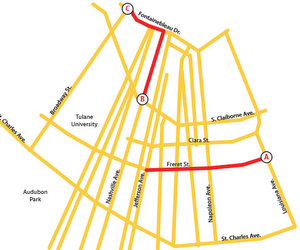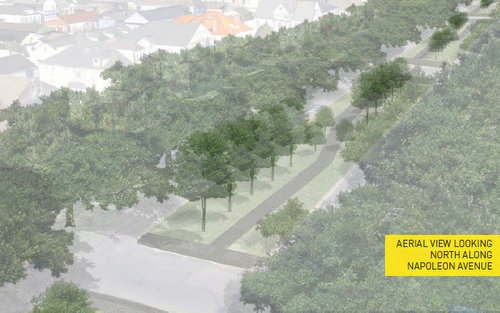
Map of upcoming repaving projects on Freret, Nashville and Fontainebleau. (via pavinglaroads.com)
That project will join a series of others — a similar repaving of Broadway Street, the ongoing construction of a new drainage canal under Napoleon Avenue, the recent commencement of the same project on Jefferson Avenue, the upcoming start of another canal project on Louisiana Avenue, and the year-long repairs to the St. Charles Avenue streetcar line — that place most of the major thoroughfares through the interior of Uptown New Orleans under some sort of roadwork.
Returning to Freret
Freret is soon to see two simultaneous projects begin in August, according to an update this week from city spokesman C. Hayne Rainey. First, the contractor that installed new bump-outs along the corridor must return to repair six corners at Valmont, Robert and Cadiz streets, making them accessible for people with disabilities. Another contractor will then begin repairing damaged sidewalks and street tiles along the corridor as the final phase of the Freret streetscape renovations.
The city is coordinating that project, however, with the upcoming repaving of Freret Street under a federal program known as Paths to Progress, which is also set to start in August. That $3.3 million endeavor will actually include a separate stretch of Nashville Avenue and Fontainebleau Drive as well, and like the streetscape, is expected to be finished in the fall.
The last round of the streetscape program was plagued with problems, however. It was repeatedly delayed — awkwardly overlapping at one point with the heavily-attended Freret Street Festival — and owners of newly-opened businesses complained bitterly about how long their entrances were blocked by construction. Orange barriers surrounded Origami sushi restaurant for so long after their opening day, for example, that the business association sought (unsuccessfully) for the city to buy the restaurant advertising as compensation for the lost business.
Memories of that still-unfinished project create an apprehensive mood in the neighborhood toward the newest round of construction on the street.
“I would almost forgo it, based on the pain we’ve just endured with the bumpout project,” said Kellie Grengs of The New Freret business and property owners’ association. “I do not look forward to it at all. Thinking about it keeps me up at night.”
Andrew Amacker, president of the Freret Neighbors United group, says that the damage to the street needs the repaving, and that residents will find routes to get around the work. Freret’s surge in popularity as a destination should help sustain the businesses, he said — as long as the work does not drag on interminably.
“A lot of our businesses are established enough that they can still attract, even through circumstances like this,” Amacker said. “Am I thrilled about it? No, because it hurts the businesses. But it’s also something we were expecting a year ago.”
A year ago, alternate routes might have been easier to find. Napoleon’s oaks had only just received their “horrible haircut,” but most of the lanes and intersections were still free-flowing. The monk parakeets of Jefferson Avenue were still undisturbed in their palms, as tree-cutting construction there was still a distant prospect. Now, Broadway and Leonidas are being repaved, and streetcar line maintenance from Jefferson upriver to Carrollton and on to South Claiborne blocks numerous intersections along St. Charles Avenue and will continue through the end of the year. Next up, the Southeast Louisiana Urban Flood Control program will begin installing a third new drainage canal under Louisiana Avenue, with work to begin after the bid is awarded in January.
‘Temporary inconvenience?’
The growing number of simultaneous project is drawing steadily more ire from residents, as shown by growing attendance at public meetings about the projects. At a presentation earlier this year about the Jefferson project that drew more than 150 people, Col. Ed Fleming of the U.S. Army Corps of Engineers was asked precisely that — why everything at once?
If the three drainage projects on Jefferson, Napoleon and Louisiana were lined up one at a time, Fleming replied, construction would last nine years or more.
“I hope the temporary convenience will be displaced very quickly by the long-term benefits of this project,” Fleming said at the time.
City Councilwoman LaToya Cantrell, in an interview this week, said she understands residents’ frustrations.
“Many of these projects have taken some time to get to this point,” Cantrell said. “Some of this work should have been completed prior to now. Unfortunately, it wasn’t, and our residents are going to be negatively impacted temporarily.”
The drainage projects, in particular, are worth it, Cantrell said. Prior to the initial drainage-canal segment on Napoleon Avenue in the early 2000s, Broadmoor flooded repeatedly from rainfall, she said. But with it in place, even rainwater from Hurricane Katrina drained away — her house and her neighborhood were dry until the levees failed, she said. But Broadmoor bore more pain from the project than other neighborhoods should have to, Cantrell said: Vibrations from the project damaged homes so severely that the Broadmoor Improvement Association filed a class-action lawsuit prior to Katrina, and the Corps now routinely touts the new, pressure-based equipment it uses to insert piles with far less vibration.
As part of the compensation for that damage, Broadmoor received the stately walking path down the center of the Napoleon Avenue neutral ground, Cantrell said. Now that her City Council district represents the entire area, she and the city Department of Public Works are actively investigating opportunities to extend that walking path all the way down to Magazine Street after the drainage canal is installed — this time, by leveraging federal interest in landscaping as a way of stormwater management.
So as construction engulfs yet another main drag through Uptown, Cantrell said she believes the work will eventually be worth it.
“We have to stay focused on the end goal, which is improved infrastructure,” Cantrell said. “We’re just pushing for it to be done right, and to be done on time.”

Rendering of a possible walking path down Napoleon Avenue by architect Wes Michaels. (via City Councilwoman LaToya Cantrell)
A version of this article was first published in Gambit through our news-reporting partnership.